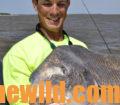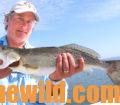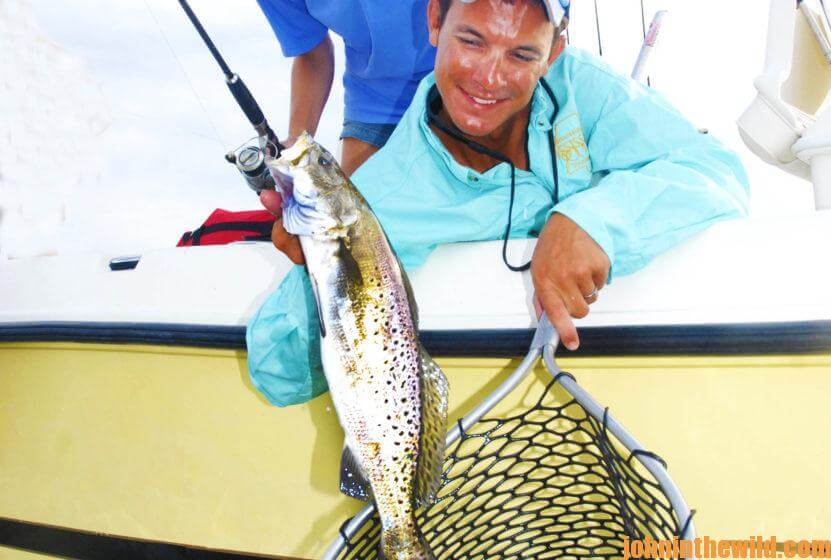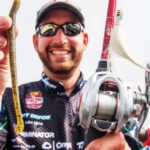Editor’s Note: Last week I gave you a roundup of offshore fishing in the Gulf of Mexico on the Upper Gulf Coast off Alabama’s shoreline with Captain Troy Frady. This week we’ll be looking at inshore fishing in late May and June with Captain Sonny Schindler and Shore Thing Charters (https://www.shorethingcharters.com/), headquartered at Bay St. Louis, Mississippi.
 John E. Phillips: As the rains stop, and the flooding along the Gulf Coast starts to decrease, how will you find speckled trout and redfish when the water becomes saltier, and the fresh water begins to slow-down and not flood the Gulf Coast?
John E. Phillips: As the rains stop, and the flooding along the Gulf Coast starts to decrease, how will you find speckled trout and redfish when the water becomes saltier, and the fresh water begins to slow-down and not flood the Gulf Coast?
Captain Sonny Schindler: In the last few days of mid-May, I’ve have been seeing quite a few schools of mullet in shallow water – 1-1/2 – 2 pounds each, which is a size too big for the redfish and speckled trout to eat. But yesterday in mid-May, I saw two or three schools of finger mullet – small mullet about 1-1/2 to 3-inches long, which makes them ideal baitfish for the 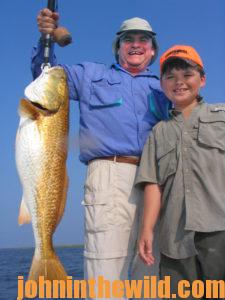 speckled trout, redfish and flounder to eat. Those schools of finger mullet I spotted were swimming right along the edge of the bank. We started fishing around that school of finger mullet, and for about 35-45 minutes, we caught speckled trout, redfish and/or flounder on almost every cast. So, one of the things our guides at Shore Thing Charters are trained to do is look for bait like finger mullet, shrimp, menhaden and schools of small baitfish that the inshore fish will eat. The game fish
speckled trout, redfish and flounder to eat. Those schools of finger mullet I spotted were swimming right along the edge of the bank. We started fishing around that school of finger mullet, and for about 35-45 minutes, we caught speckled trout, redfish and/or flounder on almost every cast. So, one of the things our guides at Shore Thing Charters are trained to do is look for bait like finger mullet, shrimp, menhaden and schools of small baitfish that the inshore fish will eat. The game fish 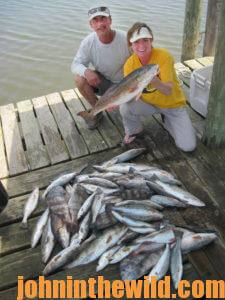 we’re trying to catch have to eat every day – regardless of weather and wind conditions. So, when we find the right bait and the best locations, we’re pretty confident we can catch the fish we want to catch by fishing around those schools of baitfish. I have fished places before where there were acres and acres of baitfish. When there’s that much bait in a location, the game fish will scatter out and be hard to catch because there’s so-much bait available. However, when you find small groups of bait fish like the school of finger mullet we discovered yesterday, the specks, reds and flounder will concentrate to feed on those schools of bait. Then you’ll have a great day of catching and not just fishing.
we’re trying to catch have to eat every day – regardless of weather and wind conditions. So, when we find the right bait and the best locations, we’re pretty confident we can catch the fish we want to catch by fishing around those schools of baitfish. I have fished places before where there were acres and acres of baitfish. When there’s that much bait in a location, the game fish will scatter out and be hard to catch because there’s so-much bait available. However, when you find small groups of bait fish like the school of finger mullet we discovered yesterday, the specks, reds and flounder will concentrate to feed on those schools of bait. Then you’ll have a great day of catching and not just fishing.
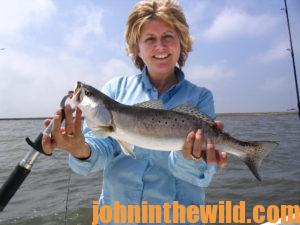 Under flood conditions, we try and catch the fish that are biting the best first. For instance, if each person can catch a limit of redfish – which is three, 18-inch long – up to 30-inch long fish per person, and you can have one redfish in that three that’s over 30 inches long, you’re having a good, early day trip. Then, you can add three or four or more speckled trout and several flounder to that catch to have a really-good day’s catch. If you can catch some puppy black drum – black drum weighing less than 8 pounds – and maybe several big black drum weighing 15-30 pounds each, you’ll have had a really-great day of fishing.
Under flood conditions, we try and catch the fish that are biting the best first. For instance, if each person can catch a limit of redfish – which is three, 18-inch long – up to 30-inch long fish per person, and you can have one redfish in that three that’s over 30 inches long, you’re having a good, early day trip. Then, you can add three or four or more speckled trout and several flounder to that catch to have a really-good day’s catch. If you can catch some puppy black drum – black drum weighing less than 8 pounds – and maybe several big black drum weighing 15-30 pounds each, you’ll have had a really-great day of fishing.
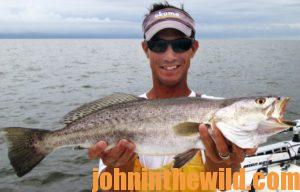 During the end of May and the first of June, the salt water usually will move back in, and the fresh water will slow-down moving into the Gulf of Mexico. We catch some of the biggest speckled trout then that we see all year long. At this time of the year, the speckled trout will be fattening-up in preparation for spawning. Usually, the water temperature and the salinity of the water are ideal for speckled-trout spawning in late May and early June. Around the full and new moons are when we see some of the biggest speckled trout of the year hitting the Mississippi Gulf Coast. The biggest trout I’ve ever seen weighed 7-1/2 pounds. But I have had reports of anglers catching them bigger than that. A speckled trout usually will run from 2 – 3 pounds each. Mississippi’s limit on trout is 15 speckled trout, 15 inches or longer, which are really-nice speckled trout.
During the end of May and the first of June, the salt water usually will move back in, and the fresh water will slow-down moving into the Gulf of Mexico. We catch some of the biggest speckled trout then that we see all year long. At this time of the year, the speckled trout will be fattening-up in preparation for spawning. Usually, the water temperature and the salinity of the water are ideal for speckled-trout spawning in late May and early June. Around the full and new moons are when we see some of the biggest speckled trout of the year hitting the Mississippi Gulf Coast. The biggest trout I’ve ever seen weighed 7-1/2 pounds. But I have had reports of anglers catching them bigger than that. A speckled trout usually will run from 2 – 3 pounds each. Mississippi’s limit on trout is 15 speckled trout, 15 inches or longer, which are really-nice speckled trout.
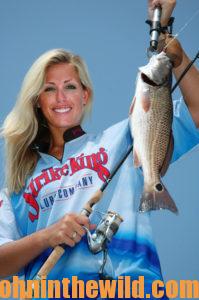 Phillips: What bait are you using from the end of May and in early June to catch those big trout?
Phillips: What bait are you using from the end of May and in early June to catch those big trout?
Schindler: Our most-productive bait seems to be live shrimp in late May and June, and the bait and tackle shops usually have plenty of them. If we’re fishing over oyster shells or along the edges of the grass, we will put a cork up the line to keep from getting hung on the shells and the grass. If we’re fishing shady bottoms, mud bottoms or scattered oyster shells, we’ll fish a Carolina-rigged live shrimp.
 Also, when we catch speckled trout, we’ll look at the bottom of their bellies for red marks that indicate that they are cleaning out a bed in preparation for the spawn. If we’re catching a good number of trout with red marks on their bellies, I’ll fish the Carolina rig. Instead of putting a cork up the line to keep the shrimp off the bottom, I’ll use a 20-pound test fluorocarbon leader line attached to a barrel swivel as my main line. I’ll use the lightest lead that I can possibly use up the line from the swivel to keep the bait close to the bottom, without interfering with the shrimp’s normal swimming pattern.
Also, when we catch speckled trout, we’ll look at the bottom of their bellies for red marks that indicate that they are cleaning out a bed in preparation for the spawn. If we’re catching a good number of trout with red marks on their bellies, I’ll fish the Carolina rig. Instead of putting a cork up the line to keep the shrimp off the bottom, I’ll use a 20-pound test fluorocarbon leader line attached to a barrel swivel as my main line. I’ll use the lightest lead that I can possibly use up the line from the swivel to keep the bait close to the bottom, without interfering with the shrimp’s normal swimming pattern.
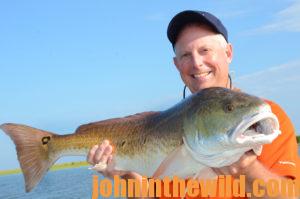 If we start catching numbers of redfish, I’ll take the 20-pound test leader line and add a 40-pound-test full carbon leader. Most of the time our water will be a little off-color, which allows us to use a somewhat heavier line than we normally will use in extremely-clear water. Most of the water we’ll be fishing will be 4-foot deep or less. The deepest water we’ll fish for speckled trout will be 6-8 feet deep.
If we start catching numbers of redfish, I’ll take the 20-pound test leader line and add a 40-pound-test full carbon leader. Most of the time our water will be a little off-color, which allows us to use a somewhat heavier line than we normally will use in extremely-clear water. Most of the water we’ll be fishing will be 4-foot deep or less. The deepest water we’ll fish for speckled trout will be 6-8 feet deep.
Phillips: Are you only catching speckled trout when you use these types of rigs?
 Schindler: No, we don’t put a label on our shrimp that says, “Only for speckled trout.” The two rigs that I’ve suggested means I’ll catch speckled trout, redfish, flounder and black drum on them. And, every once in a while, a pompano or possibly a sheepshead or even a shark may be caught when fishing around the barrier islands off Mississippi’s Gulf Coast. If you hit a perfect day, and the weather, the water and the fish are cooperating with you, with three people in the boat, you may catch three limits of speckled trout in 30-45 minutes of fishing, and then we’ll go fishing for redfish, flounder and tripletail.
Schindler: No, we don’t put a label on our shrimp that says, “Only for speckled trout.” The two rigs that I’ve suggested means I’ll catch speckled trout, redfish, flounder and black drum on them. And, every once in a while, a pompano or possibly a sheepshead or even a shark may be caught when fishing around the barrier islands off Mississippi’s Gulf Coast. If you hit a perfect day, and the weather, the water and the fish are cooperating with you, with three people in the boat, you may catch three limits of speckled trout in 30-45 minutes of fishing, and then we’ll go fishing for redfish, flounder and tripletail.
To contact Captain Sonny Schindler call 228-342-2206, Email: info@shorethingcharters.com or visit https://shorethingcharters.com.
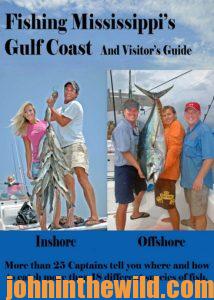 To learn more about Upper Gulf Coast Fishing, check out John E. Phillips’ book “Fishing Mississippi’s Gulf Coast and Visitor’s Guide” at http://amzn.to/XkluEO. You may have to copy and paste this address into your browser. You also can go to John’s Author’s Page at http://amzn.to/XW2URC to learn about his other outdoor books.
To learn more about Upper Gulf Coast Fishing, check out John E. Phillips’ book “Fishing Mississippi’s Gulf Coast and Visitor’s Guide” at http://amzn.to/XkluEO. You may have to copy and paste this address into your browser. You also can go to John’s Author’s Page at http://amzn.to/XW2URC to learn about his other outdoor books.
Tomorrow: Anglers can Catch Redfish and Flounder after Speckled Trout on Mississippi’s Gulf Coast

